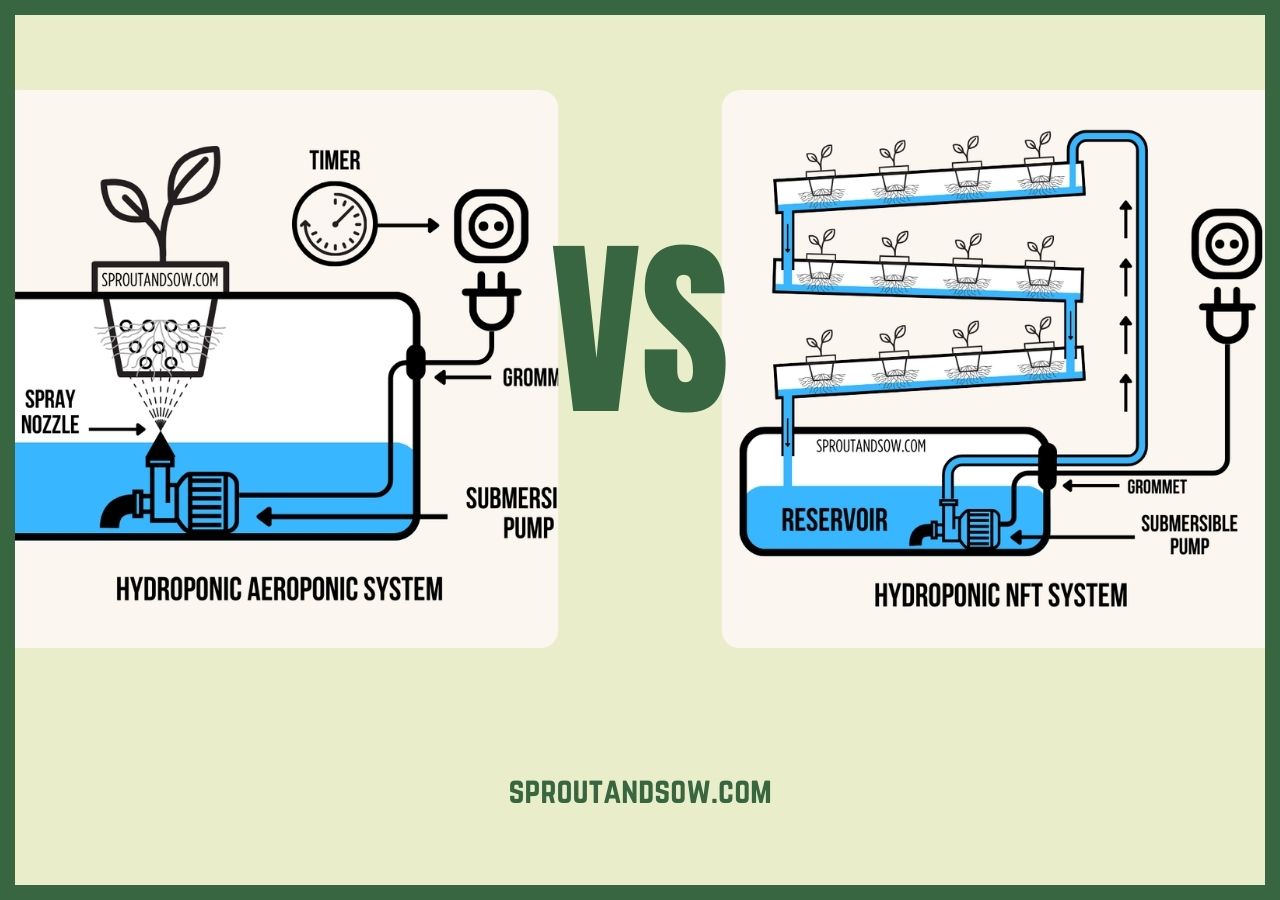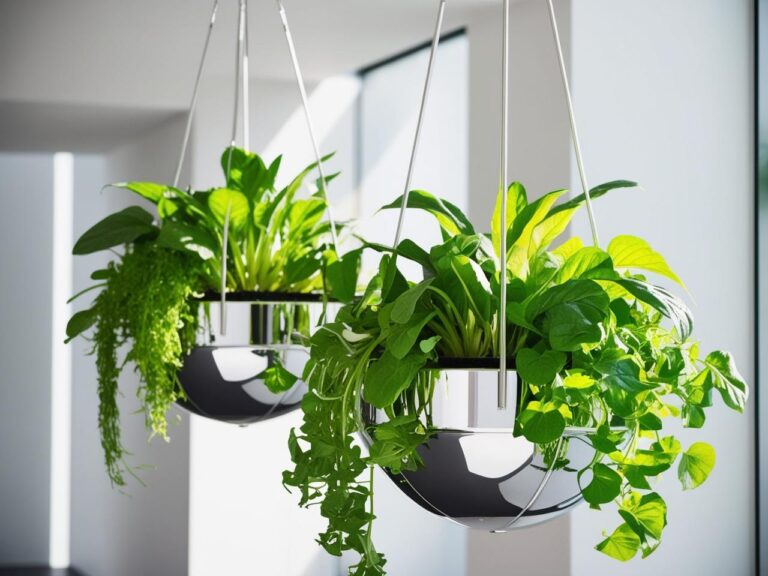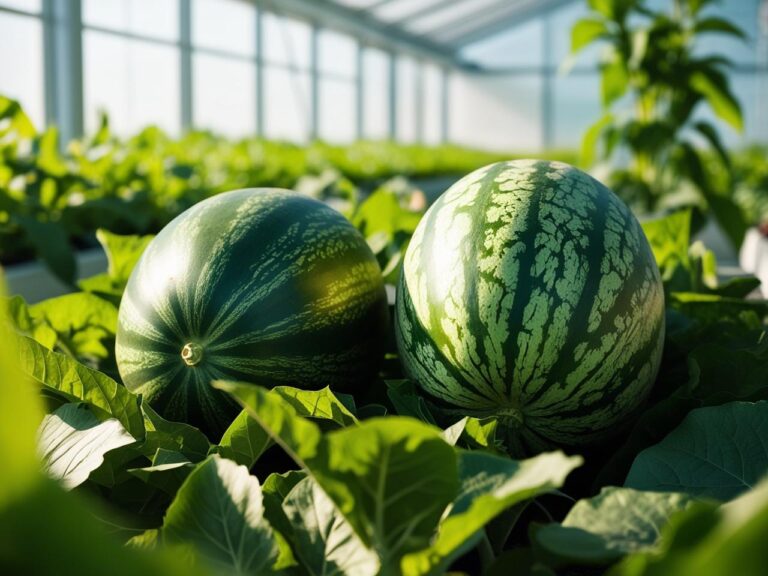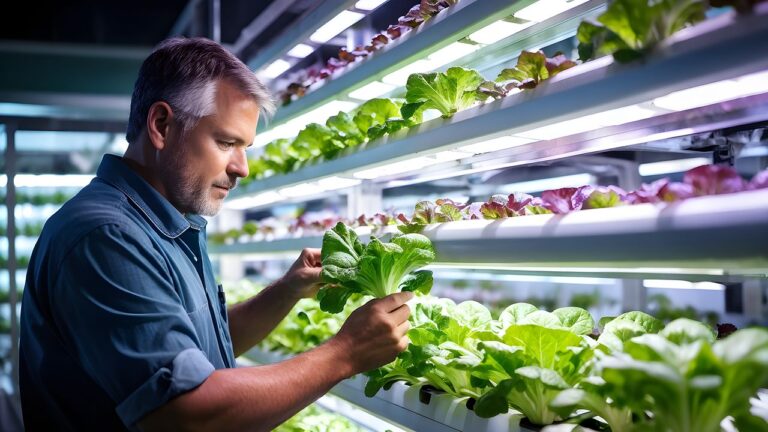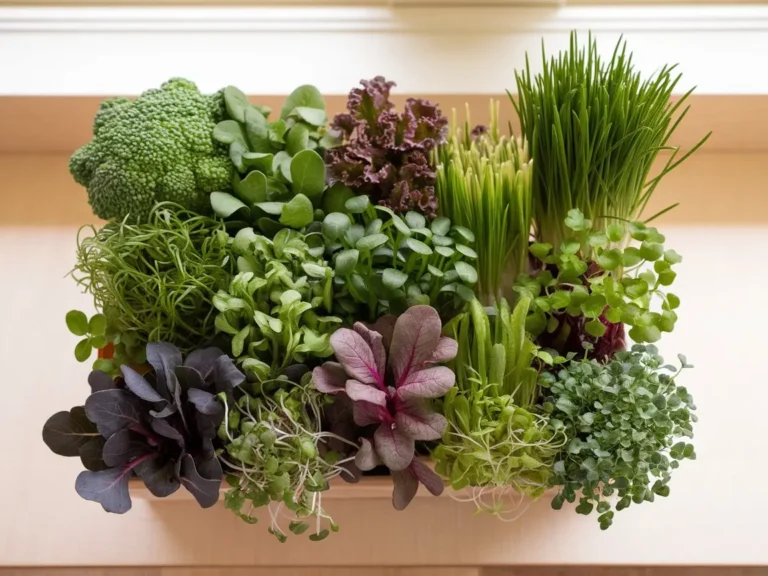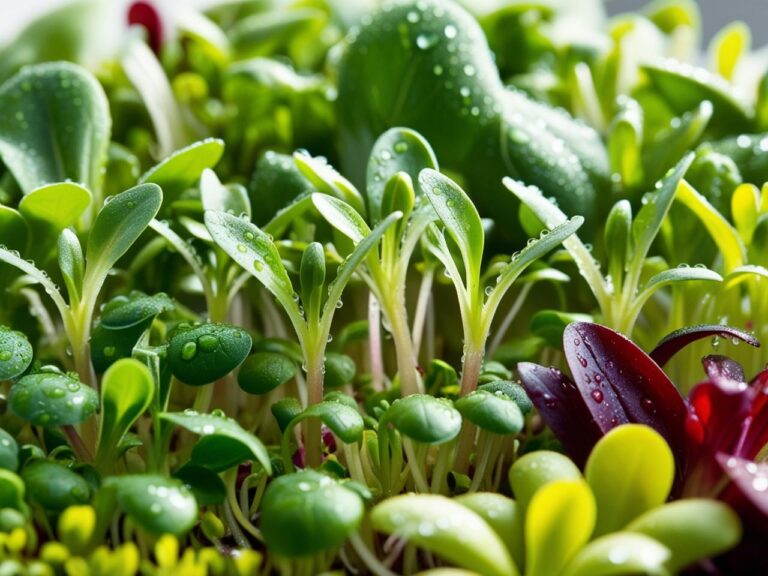Exploring Advanced Hydroponic Techniques: Aeroponics vs. Nutrient Film Technique (NFT)
If you’re diving deeper into hydroponics, you’ve likely heard of Aeroponics and Nutrient Film Technique (NFT) as popular advanced methods. These techniques cater to serious growers and allow you to control every aspect of your plants’ environment, often leading to healthier growth, bigger yields, and more efficient water use. But which one is right for you? Let’s explore what makes each method unique, their pros and cons, and which plants thrive in each environment.
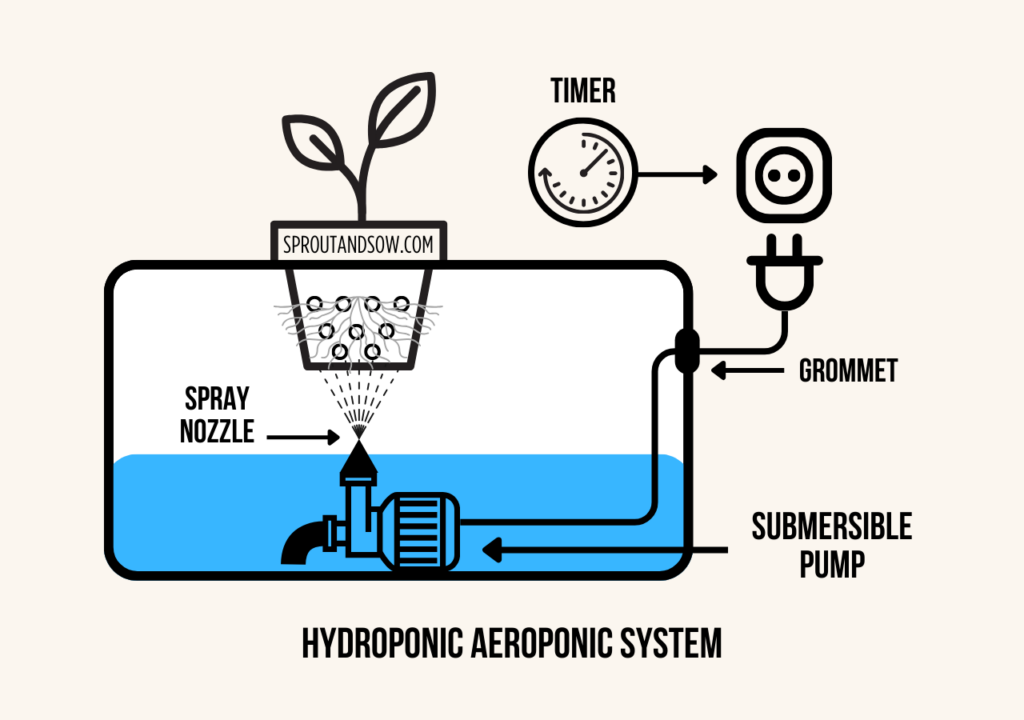
What is Aeroponics?
Aeroponics is a method of growing plants with their roots suspended in air while misted with nutrient solutions. Unlike other hydroponic systems that submerge roots in water, aeroponics provides nutrients in a fine mist, exposing roots to high oxygen levels.
- Key Features:
- Roots in Air: Roots are freely suspended in a closed environment with no growing medium.
- Misting Nutrients: A pump regularly mists roots with a nutrient-rich solution.
- High Oxygenation: Since roots are in the open air, they receive optimal oxygen, which supports faster growth.
- Pros:
- Maximized Root Exposure: Exposed roots receive both nutrients and oxygen, leading to quicker growth.
- Efficient Nutrient Use: Less water and nutrients are wasted since the mist is directed precisely where it’s needed.
- Faster Growth Rates: Plants generally grow faster in aeroponic setups compared to other systems, thanks to this continuous nutrient delivery.
- Cons:
- High Maintenance: Regular cleaning is essential, as misting nozzles can clog, and nutrient solutions must be closely monitored.
- Power Dependency: Aeroponics relies heavily on pumps and timers, so a power outage could lead to root drying.
- Best Plants for Aeroponics: Leafy greens, herbs, strawberries, and other small, lightweight plants thrive in aeroponics. These plants benefit from the quick access to nutrients and oxygen, which supports rapid, healthy growth.
Related: How Aeroponic Towers Work
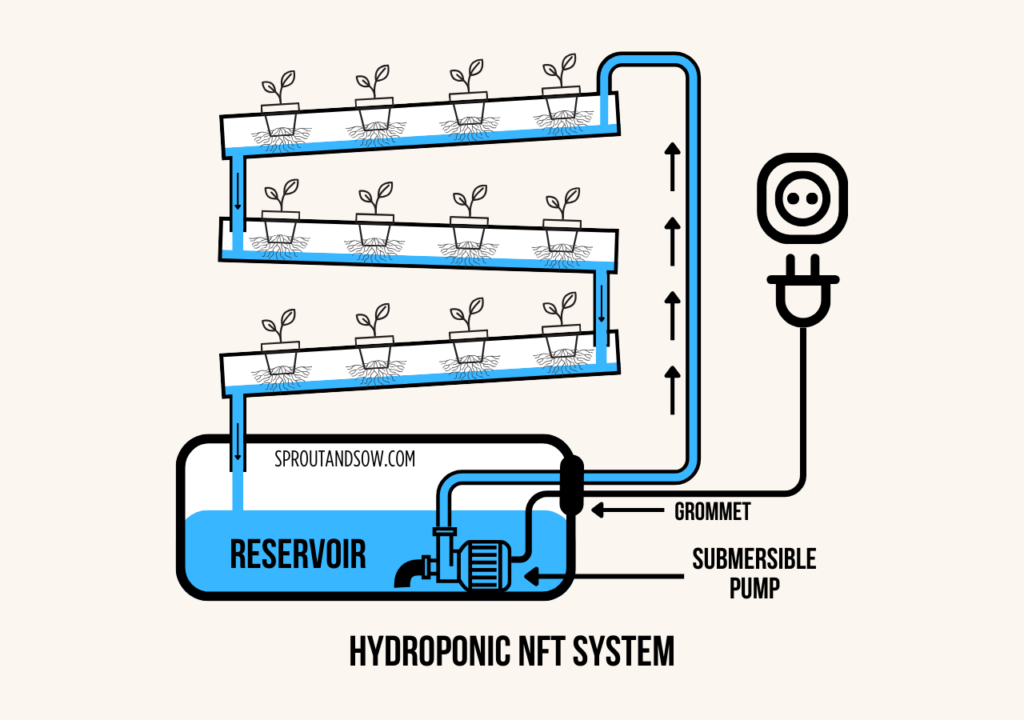
What is the Nutrient Film Technique (NFT)?
The Nutrient Film Technique (NFT) involves a thin, continuous flow of nutrient solution along the roots, which sit in a slightly tilted, shallow channel. The constant nutrient film feeds plants while leaving part of the roots exposed to air for oxygenation.
- Key Features:
- Continuous Nutrient Flow: A pump circulates a thin layer of nutrient solution that flows over the roots.
- Shallow Tilted Channel: Channels are tilted to keep the solution moving, delivering consistent nutrients.
- Partially Exposed Roots: As the nutrient film flows, roots absorb nutrients while remaining exposed to air for oxygen.
- Pros:
- Efficient Nutrient Circulation: Nutrients are delivered directly to roots with minimal waste, perfect for conserving water and nutrients.
- Ideal for Smaller Spaces: NFT systems are compact and can be stacked, making them ideal for small-scale or vertical setups.
- Lower Nutrient Waste: The continuous flow allows nutrients to be recirculated, reducing waste and cost.
- Cons:
- Risk of Root Drying: If the flow is interrupted due to a pump failure or power outage, roots can dry out quickly.
- Less Room for Large Plants: NFT is best suited for plants with shallow roots. Heavier or large-rooted plants may block channels and disrupt flow.
- Best Plants for NFT: Shallow-rooted plants like leafy greens, herbs, and other lightweight crops thrive in NFT systems, as their roots can easily access the flowing nutrient film without needing a deep reservoir.
Related: The Complete Guide to Advanced Hydroponic Techniques
Comparing Aeroponics and NFT: Which is Right for You?
Each system has unique benefits and limitations, so choosing one depends on your resources, plant types, and goals.
- System Maintenance: Aeroponics requires diligent maintenance and cleaning to prevent misting nozzles from clogging, while NFT needs channel upkeep to avoid nutrient buildup or root blockage.
- Space and Setup Needs: Aeroponics requires more vertical space for hanging root structures, while NFT systems are compact and well suited for smaller spaces or stacked setups.
- Cost Considerations: Aeroponics systems are often more expensive to set up due to misting equipment, while NFT systems are generally simpler and cheaper to maintain.
- Efficiency and Yield: Aeroponics offers fast growth rates and high yield potential, but NFT provides efficient nutrient use and a compact setup, ideal for hobbyists or small scale growers.
- Environmental Control: Aeroponics benefits from close humidity and temperature control to keep the mist flowing effectively, while NFT’s continuous flow can tolerate slightly more environmental fluctuation.
Which Plants Thrive in Aeroponics vs. NFT?
Aeroponics is ideal for plants that need high oxygen exposure, like lettuce, herbs, and lightweight crops. Fast growing plants perform well here due to the constant misting and nutrient access.
NFT is best suited for leafy greens, herbs, and shallow rooted plants. These plants don’t require extensive root support and can adapt well to the shallow, flowing nutrient film.
Related: Maximizing Yields with Advanced Hydroponic Lighting Solutions
Common Challenges and How to Address Them
Aeroponics:
- Risk of Blockage: Regularly clean and monitor misting nozzles to prevent clogs. Using filtered water can also reduce the likelihood of blockage.
- Power Dependence: Invest in a backup power source to maintain nutrient misting if there’s a power outage.
NFT:
- Root Drying: Ensure the pump is reliable and test the flow regularly to prevent dry roots.
- Channel Cleanliness: Keep channels clean and avoid nutrient buildup by flushing the system periodically. Adding an anti-clogging agent can help keep channels clear.
Conclusion
Both aeroponics and the Nutrient Film Technique (NFT) offer innovative approaches to hydroponic gardening, each with its strengths. Aeroponics is ideal for gardeners with a bit of technical expertise, offering high oxygenation and faster growth, while NFT is efficient and compact, perfect for growing leafy greens and herbs. Happy Gardening!

